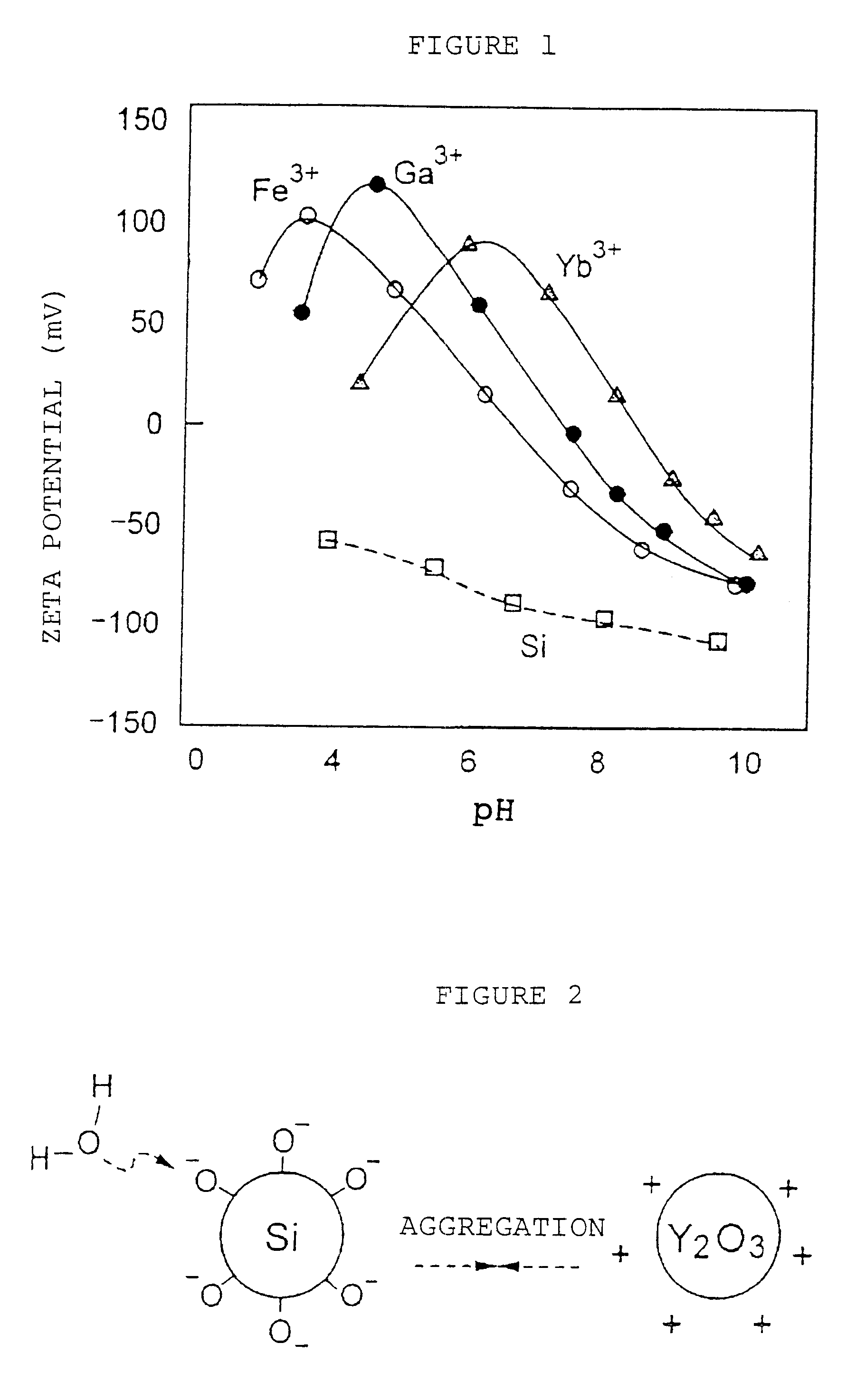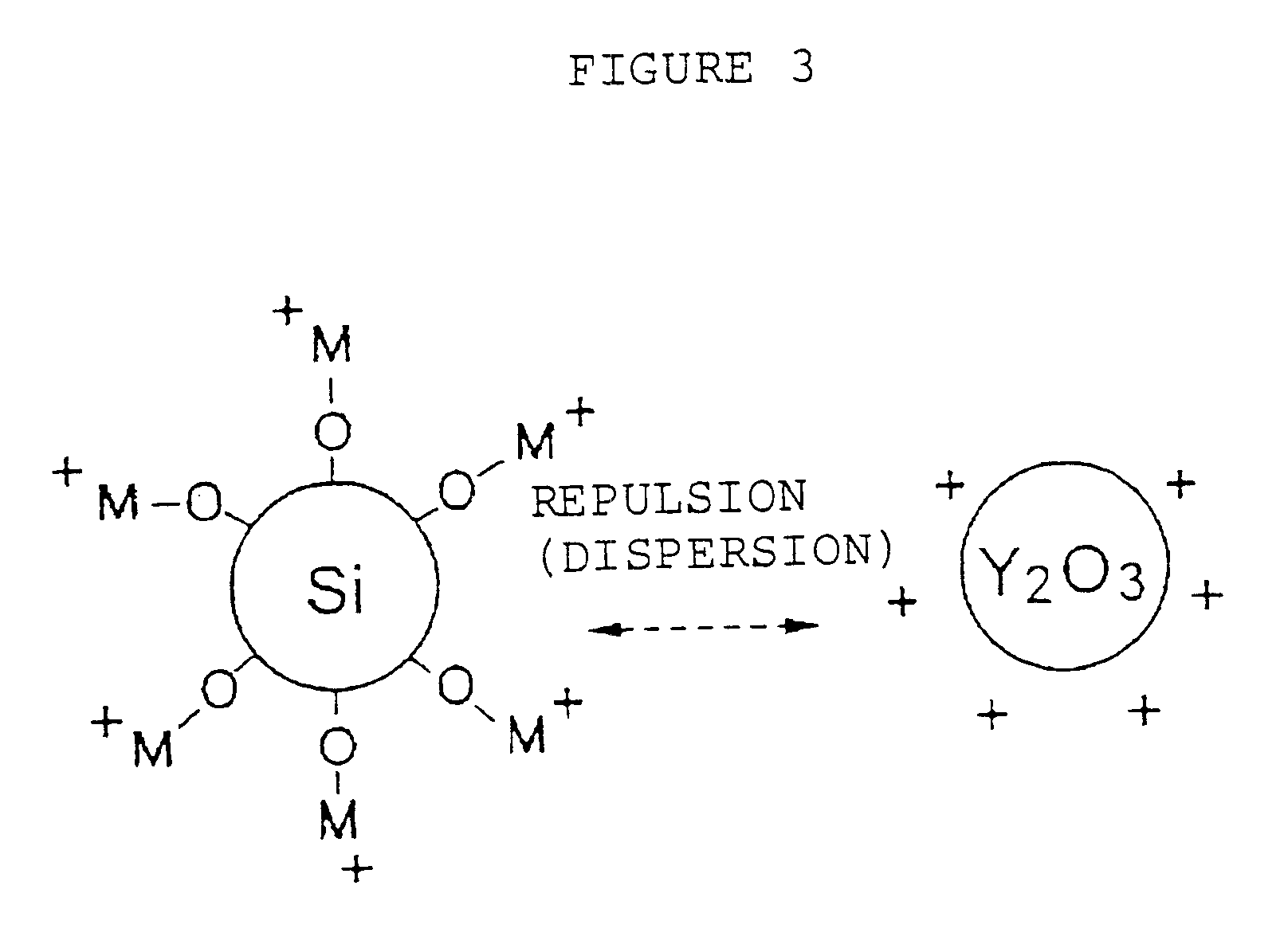Si3N4 ceramic, Si-base composition for its production, and method for its production
a technology of si-base and ceramics, applied in the field of si-base composition, can solve the problems of reducing the intrinsic outstanding properties of si.sub.3 n.sub.4, expensive explosion-proof facilities, and affecting the production efficiency of si-base, etc., to achieve the effect of improving the oxidation resistance and dispersion properties of si powder, improving the electrical, thermal and mechanical properties, and inexpensive manufacturing methods
- Summary
- Abstract
- Description
- Claims
- Application Information
AI Technical Summary
Benefits of technology
Problems solved by technology
Method used
Image
Examples
example 2
Slurries with a final Si powder mean particle size of 1 .mu.m were prepared in the same manner as Example 1, except that a nitrate containing y.sup.3+ ions was used as the surface coating agent, and the amounts used, the slurry pH, and the amounts of water added were changed as shown in Table 2. Si.sub.3 N.sub.4 sintered bodies were prepared from the slurries in the same manner as in
example 1
ives the results of the evaluation of the properties.
TABLE 2 Final Si powder Amount Amount Surface Of Y.sup.3+ of water oxygen Si.sub.3 N.sub.4 sintered body Added added content Density Strength Sample (wt %) (wt %) pH (wt %) (%) (MPa) 16* 0.01 70 6 5.0 85 750 17 0.05 70 6 2.0 98 1000 18 5 70 6 1.2 99 1150 19 10 70 6 1.2 99 1150 20* 15 70 6 1.2 85 750 21* 4 48 6 1.2 70 450 22 4 50 6 1.2 98 1100 23 4 75 6 1.2 99 1150 24 4 90 6 1.2 99 1150 25* 4 92 6 1.2 80 750 26* 4 70 2.8 1.2 70 450 27 4 70 3 1.2 99 1150 28 4 70 5 1.2 99 1150 29* 4 70 8.5 3.0 90 750 (Note) Samples with asterisks are comparative examples.
The results of Table 2 show that the samples of the present invention gave Si.sub.3 N.sub.4 sintered bodies with a high relative density and flexural strength. When the amount of the surface coating agent, the amount of water, or the pH were outside the ranges stipulated in the present invention, however, the powders were inadequately dispersed, or the Si powder was considerably oxid...
example 3
Slurries were prepared in the same manner as in Example 1 (using a nitrate containing y.sup.3+ as the surface coating agent) except that the extent to which the Si powder was milled in the aqueous solvent (final Si powder mean particle size), the type and total amount of the sintering aid, and the amount of organic binder for molding were changed as shown in Table 3. Si.sub.3 N.sub.4 sintered bodies were prepared from the thus obtained slurries in the same way as in Example 1. The properties of the slurries and Si.sub.3 N.sub.4 sintered bodies were assessed in the same manner as above, with the results given in Table 3.
TABLE 3 Final Si powder Amount Si.sub.3 N.sub.4 Particle of sintered body size Sintering aid binder Density Strength Sample (.mu.m) Type wt % (wt %) (%) (MPa) 30 0.05 Y.sub.2 O.sub.3 + MgO 10 5 97 750 31 0.1 Y.sub.2 O.sub.3 + MgO 10 5 99 1250 32 0.8 Y.sub.2 O.sub.3 + MgO 10 5 99 1350 33 5 Y.sub.2 O.sub.3 + MgO 10 5 99 1100 34 10 Y.sub.2 O.sub.3 + MgO 10 5 99 1000 35* ...
PUM
| Property | Measurement | Unit |
|---|---|---|
| mean particle size | aaaaa | aaaaa |
| particle size | aaaaa | aaaaa |
| flexural strength | aaaaa | aaaaa |
Abstract
Description
Claims
Application Information
 Login to View More
Login to View More - R&D
- Intellectual Property
- Life Sciences
- Materials
- Tech Scout
- Unparalleled Data Quality
- Higher Quality Content
- 60% Fewer Hallucinations
Browse by: Latest US Patents, China's latest patents, Technical Efficacy Thesaurus, Application Domain, Technology Topic, Popular Technical Reports.
© 2025 PatSnap. All rights reserved.Legal|Privacy policy|Modern Slavery Act Transparency Statement|Sitemap|About US| Contact US: help@patsnap.com



